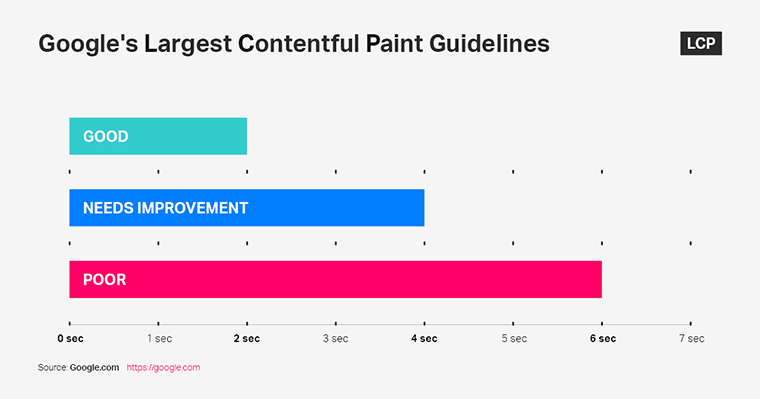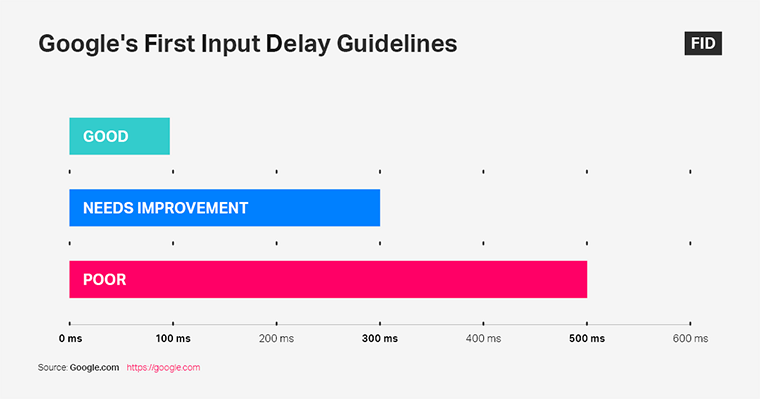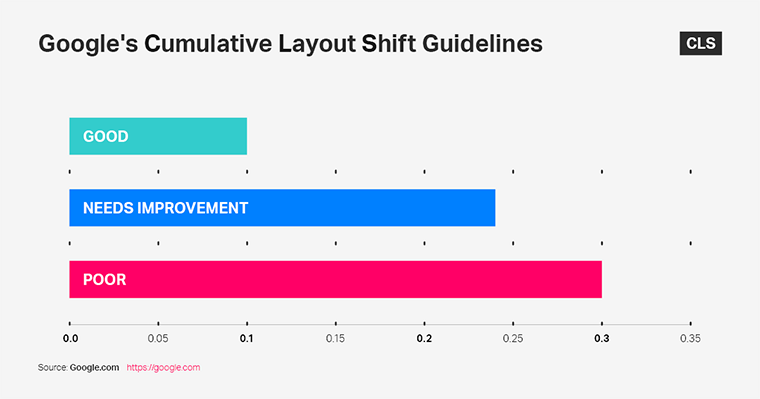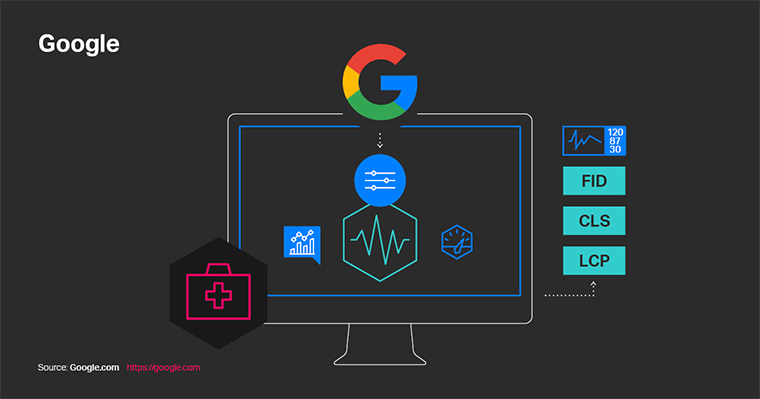What are Core Web Vitals?
Essentially, Core Web Vitals (CWV) is Google’s way to narrow down the factors that help to evaluate the quality of a website’s user experience. These new metrics include three variables: Largest Contentful Paint, First Input Delay, and Cumulative Layout Shift.
1. Largest Contentful Paint (LCP) stands for the website’s loading time and takes into account how quickly the written and media content is loaded. Google states that LCP can significantly affect the bounce rate of the pages, according to their report. The recommended Google’s load time for the page is 2.5 seconds. However, the research shows that most users expect this number to be less than 2 seconds.

2. First Input Delay (FID) is arguably the most important metric of all three, and it measures the time when a user interacts with the site and the website’s reactions to the user input. This factor helps to determine user experience satisfaction. For example, FID measures the time it takes for the browser to respond to the request generated by a visitor. First Input Delay should not be longer than 100 milliseconds; otherwise, it can affect the website’s rankings.

3. Cumulative Layout Shift (CLS) is the metric that estimates the extent of the page’s visual stability and content shifts during the load. CLS is on the lookout for the content and media that move around before rendering the web page. The unstable content elements have a negative influence on the UX. Therefore Google advises having a CLS value of no more than 0.1.

How to measure Core Web Vitals?
The obvious question arising from the news about the new changes is measuring Core Web Vitals and preparing for the rollout. There are a few ways to estimate the required metrics:
- Google Search Console (GSC) now offers the Core Web Vitals tab to help publishers calculate their CWV scores across the website. It provides info on the pages that require attention and which factor of CWV lacks behind.
- Google PageSpeed Insights has an option of measuring CWVs in the field and lab report sections.
- Google Lighthouse. The latest 6.0 version provides detailed reports on the CWV score and includes CLS and LCP metrics in their page analysis.
- Chrome Dev Tools has been updated to help with the various page load instabilities and CLS factor.
- CrUX or Chrome UX Report accumulates collective reports about user experience across thousands of websites but recently has been updated to gather data on Core Web Vitals.
- Web Vitals Extension can be installed from Google Chrome Web Store and allows to estimate all three CWV scores in real-time.
Core Web Vitals Effect on Ads
Due to the very nature of the update, compliance with Core Web Vitals will mainly affect the ad content of the web page, depending on the type and complexity of the latter. CLS factor is especially sensitive to the slow load and unstable media. So it is only logical that publishers should adjust and make sure that their ad content brings money while keeping up with CWVs requirements. Here are some of the ways the new Google’s metrics can affect ads:
CLS troubles
There are two main ways to slaughter the CLS score and lower your rankings to maximize ad revenue. The first is to let ad media of different heights share the same ad space, and the second is to renew ad calls for idle users. These issues tend to facilitate jumpy content and lead to a user being thrown to a different part of the web page. To avoid these problems, one must always choose the largest available height for an ad and manage the refresh logic accordingly.
Impact on heavy ads
Heavy ads usually have a detrimental effect on UX as they eat up way too much data and battery life. If such ads exceed the limit by Google’s estimates, it does not show the ad altogether. To avoid such outcomes, publishers should evaluate the ads and their CPU usage, getting the tools and resources to avoid media deemed too heavy. The CWV description shows that the stagnation of content load on any web page will affect the rankings and search engine results.
Rendering of ads
FID factor is heavily impacted by content that takes a long time to render, negatively affecting the UX, thus spoiling the CWV score. In order to avoid such issues, try implementing lazy load ads that are loaded and served in real-time as the user scrolls towards them.

Why are Core Web Vitals important for publishers?
We have already touched upon this topic; however, it is worth exploring more thoroughly as these metrics are crucial to web sources’ success. Designed to optimize the viewer’s experience on the website, Google strives to create a more consistent and UX-oriented digital environment. Without adherence to these new measures, publishers can suffer significant losses, eventually missing out on revenues. Let’s see the main points tied to CWV metrics that are paramount for the publishers:
- Google rankings. The most obvious reason publishers should notice CWV and comply with new guidelines is the search engine ranking. Core Web Vital measurements will majorly affect both desktop and mobile search results, and if your website is slow and glitching – someone else will take the lead. Needless to say, the loss of the search engine ranks can have a devastating effect on the website’s advertising revenues. Google’s requirements might hurt SEO efforts significantly, effectively negating the big layer of relevant SEO work and lowering potential visibility and thus website revenue.
- UX is a top priority. One of the most fundamental goals of CWV rollout is to improve the overall user experience, so it is no wonder that this factor will highly affect publishers, especially those who rely upon heavy graphics and media content.
- User engagement potential. Due to the overall UX improvement, the visitors’ engagement can go up as well, delivering a more relevant and quality web experience to visitors and more pageviews and time spent on the web sources for publishers, which will potentially increase the amount of impressions.
- Cross-device performance. CWV will affect both desktop and mobile, therefore improving the performance of the web sources across the devices and bringing more mobile traffic.
- Google Top Stories. Accelerated mobile pages (AMP) are no longer presented as a requirement for Google’s Top News mobile search feature, and after the implementation of the new requirements, the only requirement would be compliance with Core Web Vitals. This can affect web page’s performance on mobile devices and publishers should take action to avoid the negative consequences.
Why should programmatic publishers be aware of Core Web Vitals?
Without going into too much detail, Core Web Vitals deals with page load latency and such issues as the jumpiness of media content.
Considering that programmatic advertising, just like any other coding, can worsen the page load time, it is essential to keep the level of UX satisfaction high. Under new ranking rules set up by Google, such problems with page latency and slow content can significantly affect the Core Web Vital metrics. Poor CWV scores can, in turn, hurt SEO strategy and negatively impact Google rankings of publisher’s websites and thus the expected ad yield.
Therefore, Core Web Vitals сonstitute a powerful tool for bringing up or bringing down the advertising revenues, especially for publishers who employ programmatic. Therefore, it is crucial to take note of this new metric and adjust the advertising strategy accordingly.
What can publishers do to prepare for new Google metrics?
Google’s message is clear – it will put an extra value on web page latency, input performance, and visual stability. If publishers fail to comply with newly set standards, their rankings will suffer, affecting users and profits from advertising. To prevent these unfortunate developments, web source owners should balance their monetizing efforts with UX improvements.
One of the most convenient ways to adhere to new rules for programmatic publishers is to focus more on server-to-server bidding, which can help stabilize the issues with header bidding increased load page times. Server-to-server bidding or S2S makes a singlе call to a server on behalf of all partners instead of the multiple calls unloading the network and speeding up the load process. S2S bidding, which is available through Adtelligent products, also solves the traditional header bidding problem by correlating the number of demand partners and the slow page load. Server-to-server bidding manages to avoid this issue because the server takes up much of the processing work, leaving the web page loading times adequate despite the number of demand partners.
Boosting FID
Being one of the significant factors, keeping up with FID is relatively easy by:
- Reducing non-crucial third-party data and any related background processes and codes that affect the load speed.
- Calibrating the optimal JavaScript loading times, deleting all non-essential scripts.
- Monitoring the workload on the main thread and adjusting the page styles accordingly to gain the maximum page load speed.
- Lazy loading integrating and providing media content only upon requests to preserve the transmission capacity of a connection.
Boosting CLS
The best advice on improving CLS would be to eliminate any unrequired layout shifts and give enough space on the page for any media content such as transform animation. Also, make sure the ads are appropriately rendered and have enough height and width on the page.
Boosting LCP
Enhancing your LCP score is all about the amount of media and content on the webpage. It is especially relevant for the rankings to keep the top of the page relatively simple. Videos and rich media content are lucrative for advertisers and publishers alike. However, those types of ad placements should be moved below the fold to avoid impacting load time speed. Presenting an image for the video thumbnail can also drastically increase the speed load factor. In a nutshell, one must balance the number of ads on the page and take care of the background load because the page’s loading process stops rendering the rest. A preload command option can help with this issue and give more control over font loads.
Leveraging footer bidding
Since Google’s Core Web Vitals scores relate to site load speed and user experience prioritization, it is logical to implement more tools that put the factors mentioned earlier to the forefront. Additionally, since ads play a huge role in this dynamics, and we cannot simply get rid of them to improve the overall CWV scores, there is a need for a solution that can help publishers bring balance to website latency and monetization efforts; this is the reason behind Footer Bidding handy potential to positively affect CWV rankings, as they both prioritize user experience and content quality. While header bidding conducts the auctioning during the page load time, footer bidding waits to load the framework and put auctioning processes into action after a page is fully loaded.
Under the current metrics implemented by Google, Footer Bidding is becoming very attractive in speeding up page load times while keeping the traffic coming.
Key Takeaways
Core Web Vitals will affect not only the rankings of the websites but also the user experience. That’s why publishers must get a firm grasp of this new algorithm update and become familiar with its inner workings.
With Core Web Vitals’ announcements, Google clearly showed its vector to better the user experience and page speed; high-quality content, advertising, and a proper UX are the main goals.
Understandably, new metrics will impact publishers and require adjustments and several changes that might be worrisome to some businesses. However, the mechanics of Core Web Vitals is pretty straightforward. Numerous tools allow tracking and making changes to the websites to make them CWV-compliant. The main difficulty for publishers now is to balance the monetization efforts, quality and amount of ads, and the background processes that can negatively influence user experience, thus lowering web source rankings.